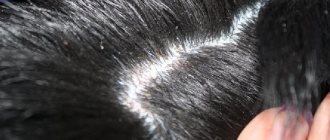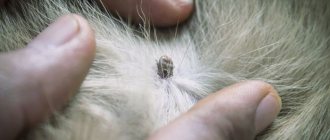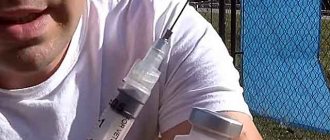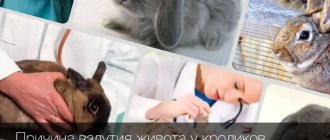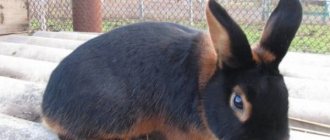Diseases
23851
Rabbit psoroptosis (Psoroptes cuniculi) is a scabies disease with the parasite localized in the external auditory canals of the ears, up to the eardrum. Ear mites are found everywhere, in any season of the year; rabbits of all ages are affected, with varying intensities. Thus, the acute form of ear scabies is characteristic of young animals from birth, but more often from 20-30 days to a year. The chronic form of psoroptosis occurs in rabbits over one year of age. The main clinical sign of rabbit ear psoroptosis is itching and/or wax in the ears.
Rabbit ear scabies is one of the main causes of secondary ear diseases in rabbits - fungal and bacterial otitis.
Ear diseases in rabbits
Ear disease in rabbits occupies a leading place in rabbit pathologies. Indeed, rabbits have locator ears, which are susceptible to many diseases of different nature. Plaque in the ears occurs with psoroptosis, otitis media, and fungal infections of the auricle. Name of the disease treatment can be continued. The correct diagnosis determines what to treat and what medicine to use. In our article you will find all the rabbit ear diseases of an inflammatory, fungal nature in the form of the most common combinations.
Ear diseases in rabbits are always associated with ear scabies and improper treatment.
How to diagnose an infection?
The veterinarian diagnoses the disease, and the owner can also examine the animal himself. For this you will need:
- Vaseline or liquid paraffin;
- thin and sharp device for removing wax;
- a small piece of glass;
- microscope or magnifying glass.
Vaseline (oil) is heated to a temperature of +40 degrees. A flap is inserted inside the ear for a while. After this, it is removed from the auricle, placed on a clean glass and carefully examined under a magnifying glass or microscope. The presence of small yellow insects will confirm that the animal is indeed infested with ticks.
Laboratory tests are carried out in a veterinary clinic with the appropriate equipment and allow you to quickly make the correct diagnosis of the animal. In addition, the specialist will determine the cause of the inflammatory process in the ears. This may require additional examinations:
- cervical smear;
- examination of the ears with an otoscope;
- computed tomography or radiography (applicable to the inner ear).
Psoroptosis in rabbits - what does an ear mite look like?
Psoroptosis in rabbits or ear scabies in rabbits is caused by a microscopic ear mite. Its Latin name is Psoroptes cuniculi.
This type of mite does not burrow into the skin
The rabbit ear mite measures from 0.4 to 0.8 mm in length. A person with very good eyesight can see a rabbit's ear mite with the naked eye. It is possible to examine the structure in detail only under a simple (school) microscope with a minimum (twenty-fold) lens magnification.
Photo. Psoroptes cuniculi at 1940s microscope magnification. The ear flare is clearly visible even with a magnification of 20x.
Prevention of ear psoroptosis in rabbits
Everyone knows that it is easier to prevent a disease than to treat it. In the case of psoroptosis, it is preventive methods that are the main ones to prevent the invasion of parasites into the body of rabbits.
Recommendations for rabbit breeders for prevention:
- Compliance with quarantine for new pets for 30 days.
- If ear scabies are detected, the animal must be immediately quarantined.
- Feeding animals with vitamin supplements.
- Keeping animals in spacious cages.
- Maintaining optimal temperature and humidity in the areas where rabbit dwellings are located.
- Elimination of drafts and direct sunlight.
- Timely cleaning of cells.
- Routine disinfection of rabbit hutches, premises and equipment (anti-parasitic treatment twice a year).
- Preventive deworming.
- Regular inspection and cleaning of rabbits, especially before mating.
- Operating personnel must carry out all manipulations only with clean, pre-washed hands with soap (in some situations, wearing sterile gloves).
A pregnant rabbit can be treated for psoroptosis even in the absence of obvious symptoms of the disease. Preventive treatment of the female's ears is carried out approximately on the 15th day of pregnancy.
A number of simple preventive measures will help protect rabbits from ear mites or prevent re-infection.
Can a rabbit suffer from otodectosis - cat ear scabies?
Externally, Psoroptes cuniculi resembles a cat's ear mite. They even belong to the same genus of mites - Psoroptes. Ear scabies in cats is called Otodectosis, and in rabbits - Psoroptosis. Meanwhile, they never parasitize each other's ears. Cases of spontaneous infection of rabbits with ear scabies from a cat are known, but the disease is mild and ends on its own without treatment. Humans also do not suffer from rabbit ear scabies. The same medications are used to treat ear mites in cats and rabbits. Acaricides are made based on the same products.
A rabbit suffering from ear mites can be treated with medications for cats
Diagnosis of psoraptosis
The symptoms listed above are quite enough to identify the disease and begin treatment immediately. But to be completely sure, you can examine the sick rabbit and study tissue fragments.
The size of an adult female ear mite significantly exceeds the size of male individuals and reaches almost 1 mm. Such impressive dimensions allow you to track the presence of parasites directly in their habitats, if you are armed with a magnifying glass. Scab scraping, mixed with heated Vaseline and smeared on glass, will also allow you to visually identify the culprits of the disease. Those who doubt the result can contact a veterinary laboratory.
How do rabbits become infected with ear mites and how does it develop?
- Infection of a rabbit with the Psoroptes cuniculi mite occurs from the first days of life through contact of baby rabbits with a nursing rabbit or baby rabbits with each other. Adult rabbits are less likely to become infected during mating, through grooming items and bedding.
- Inside the ears of a rabbit, the ear mite goes through four stages of metamorphosis (transformations): egg → larva → nymph → (protonymph → teleonymph) → imago (adult).
- Development from egg to adult is completed in approximately 14-20 days, a maximum of 1.5 months.
- The individual lifespan of an adult rabbit ear mite is from 3 to 6 weeks.
Features of ear mite infection
Young rabbits are most susceptible to ear mites. In this case, infection occurs due to contact with the mother. In young individuals, the infection can develop with complications.
Ticks can spread very quickly. If at least one rabbit is infected, the tick will be transmitted to others. The parasite thrives in the animal's ear canal. During its life, it begins to build tunnels there and lay eggs, from which new offspring will subsequently be born.
It is very important to spend more time keeping your infected rabbit clean. The infected animal experiences severe itching. In addition, there is a danger of developing inflammation of the ears. If the case is particularly advanced, meningitis may even develop, leading to the death of the rabbit.
Is it only the scabies mite that lives in a rabbit's ears?
- The only place of parasitism of the ear mite Psoroptes cuniculi is the passages of the auricle to the eardrum. Ticks fall outside the ear only to infect another animal.
- Psoroptes cuniculi belongs to the group of cutaneous parasites. However, the causative agent of ear scabies is not present on open areas of the skin, only inside the ears. Crusts on the head, neck, back are just the consequences of itching, or traces of other rabbit mites (Cheyletiosis - cutaneous mite and Leporacrus - fur mite).
- The rabbit ear mite does not make moves inside the skin; it is not an intradermal parasite. Those who claim otherwise are not professional acarologists.
- The eardrum is a natural barrier against ear mites from entering the middle and inner ear. Forced tilting of the head, drooping of the ear in a rabbit is evidence of destruction of the eardrum and complicated pathogenesis, accompanied by the release of exudate (serous, catarrhal, purulent, hemorrhagic).
- Ear mites can infest a rabbit's ears throughout the rabbit's life. In adult rabbits, latent or hidden scabies is sometimes diagnosed, which can cause serious consequences for the rabbit’s body (lymphoextravasate, ear polyps).
Can ear mites be found outside the auricle?
In animals, the location and reproduction of skin parasites occurs exclusively in the ear canals. However, sometimes ticks crawl over the body and stay on it for a short time, and then move on to other individuals. Ticks can be found on the neck, back, and limbs. It is believed that moderate sweating in this area is an excellent environment for the development of parasites.
How to understand that a rabbit has become infected with psoroptosis - ear mites
The first signs of ear scabies in rabbits, when infected from the mother, begin to appear immediately after infection.
The term “incubation period” is not used for parasitic diseases
It is replaced by the term “biological development cycle”. Based on the characteristic signs, the owner notices a disease in his pet’s ears and, based on them, seeks help from a veterinarian.
- Itching in the ear area. Rabbits scratch their ears and shake their heads, especially intensely in the first weeks of the disease. Later, as rabbits get used to the itching, they itch less often. Exhausting itching leads to depletion of the rabbit's body's defenses, stunted growth, and slower development.
- Earwax accumulates constantly, despite regular hygiene procedures in the ear canals. Earwax accumulates closer to the base of the ear. Earwax in rabbits is removed with cotton swabs. Sulfur is in the form of flakes, it can be dry or wet.
- Some rabbits become so accustomed to constant itching that they behave like healthy animals; dirty ears indicate illness. A healthy rabbit does not require ear cleaning.
If your rabbit's ears are constantly dirty, this is also a sign of ear scabies.
The final diagnosis of psoroptosis is made when mites are detected during examination of an earwax smear.
Stages of tick development
The following stages of ear mite development are distinguished:
- Laying eggs. At this stage, the female lays an egg. She is capable of laying up to 5 eggs per day. A week later, the larvae appear.
- Appearance of larvae. They get their nutrition from earwax and skin secretions. This phase lasts on average 4 days. After this, the larvae become lethargic and begin molting.
- Nymph. This stage occurs in two forms: protonymph and teleonymph. The tick remains in this state for 9 days. At this time, she actively feeds and mates.
- Imago. At this stage, the tick reaches adulthood and is already capable of laying eggs. An adult mite can live in a rabbit's ear for up to 23 days.
Important! It takes 14-16 days for the adult parasite to form. The lifespan of ticks is approximately one month.
A female tick can lay up to 60 eggs during her life. Ticks begin mating during the third stage of development, known as the nymph.
The location of parasites in the ear canal is associated with the fact that there is practically no sweating in this place.
How to spot rabbit ear mites under a microscope
Diagnosing ear mites is not difficult even at home. To do this, you need to have excellent vision, a magnifying glass or simple equipment, such as:
- a simple microscope, with a 20x objective magnification;
- slides or watch glass;
- tweezers with blunt ends;
- mineral oil, or 10% aqueous solution of baking soda;
- tailor's or dissecting needle.
Wrap a piece of cotton wool around the free end of the tweezers. If you do everything correctly, the rabbit allows you to clean your ears without special fixation. Using tweezers with dry cotton wool, carefully penetrate 2-3 cm deep into the ear and collect the wax.
Do not be afraid! It is impossible to damage the eardrum in a rabbit's ears using tweezers with blunt ends and protected with a piece of cotton wool.
Transfer the sulfur to the glass, add a drop of any liquid mineral oil or soda solution, and divide the piece of sulfur into small particles using a needle. After dissolving the crusts and focusing, you will see moving mites. The smaller the drop, the easier it is to find ticks. To better see the structure of the tick under a microscope, you can press the sample between two pieces of glass.
A tick squeezed between pieces of glass is flattened, but not destroyed.
This makes it easier to detect under a microscope. The tick in the photo illustrating the article is recorded exactly like this. The magnification of the school microscope is half that in the photo, but is sufficient for a detailed study of the tick. If you use any transparent synthetic glue (epoxy) instead of oil, then after compression and drying you will get a preparation that can be stored for a long time in the collection of micropreparations of your own zoological museum. In the same way, you can make a preparation of a cat’s mite and compare the differences. They are not significant, but they are there, check your attentiveness.
Diagnostics
To accurately determine the presence of a parasite in a rabbit’s body, you need to scrape the inside of the ear and conduct tests.
This can be done through a laboratory test, in which the collected secretions are examined by a doctor under a microscope.
Determining the parasite using a microscope There is another method that you can do at home yourself. For diagnosis you will need:
- petrolatum;
- sharp instrument;
- a piece of glass;
- magnifying glass.
Did you know? Ticks that enter the environment with pieces of epithelium or crusts can survive in suitable conditions without an animal for approximately 21 days.
Vaseline is heated to a temperature of +40 °C. What was separated from the problem area in the ear is placed in it for a short period of time. Then the substance is leveled on glass and examined under a magnifying device. The presence of mites will be indicated by movement in the substance.
Symptoms of rabbit ear scabies, psoroptosis without complications
The mouthparts of scabies mites are piercing-sucking, cone-shaped. The scabies mite feeds on lymph, tissue fluid, serous exudate, and dead epithelium of the integument of the rabbit's ear. The parasitic mite stimulates the formation of earwax.
A triad of clinically significant symptoms of rabbit ear scabies is noted immediately after infection:
- Severe itching, the rabbit shakes its head, itches constantly, the animals lose their appetite, are restless, all rabbits from the same litter (nest) have similar symptoms;
- Earwax is moderately intense, the crusts are moist, gray in color, the skin of the auricle, after cleaning, looks healthy, but forms again after a short period of time;
- Immediate allergic reactions in response to ear mite infestation. Externally it manifests itself as lacrimation, crusts under the eyes, and rhinitis. Laboratory examination of peripheral blood reveals eosinophilia and a shift to the left in rabbits.
Symptoms and signs of infection
Almost immediately after infection with psoroptosis, the rabbit’s behavior changes, which allows the disease to be detected in time. Symptoms of ear mites are:
A sick rabbit becomes restless
- Anxiety. The animal experiences severe itching in the ears, so it shakes its head, scratches the skin around the ears, rubs them against the cage and other objects.
- Decreased appetite.
- Exhaustion. If your pet is left untreated for a long time, it will lose weight.
- Crusts form inside the ears, and fragments of dried blood accumulate there. If you look into a rabbit's ears, you can see a brown mass.
- Ears are hot and painful. When trying to inspect them, the rabbit resists.
Attention! The contents of the auricles gradually increase in volume, over time it can completely block the ear canal.
Symptoms of rabbit ear scabies, psoroptosis with complications
Ear scabies can be complicated by otitis of bacterial or fungal etiology, damage to the integument of the auricles, and accordingly, the symptoms of complicated forms have their own characteristics. It is impossible to describe all the options, see the main ones below.
- The intensity of the itching may decrease, but scratching appears on the neck, behind the ears, and even bloody scabs.
- Earwax is an obligatory companion to rabbit psoroptosis; the nature of the plaque on the inside of the ears can take the form of plaster crusts, scabs due to the layering of dermatomycosis, moist of varying consistency with and without odor - bacterial otitis.
- There are gray crusts around the eyes and nose, which can be removed with a cotton swab.
- An unfavorable symptom is the appearance of liquid exudate in the auricle. It is discovered during cleaning, this is the first signal of destruction of the eardrum, replacing itching with a pain reaction.
- Destruction of the eardrum in a rabbit is manifested by a forced tilt of the head, drooping of the ear, and purulent, foul-smelling discharge.
- Because the rabbit shakes its head and ears. In the inside of the ear, rupture of the lymphatic vessels can occur; this pathology is called lymph extravasation.
Mycoses (microscopic fungi) complicating ear scabies
Sometimes ear mites are confused with similar diseases that accompany scabies in the ears of rabbits, which are accompanied by discharge from the ears. Psoroptosis - scabies of rabbit ears, when prolonged, is complicated by the pathogenesis of fungal and/or bacterial otitis. Ear discharge due to mycoses and bacterial infections accompanying scabies complements the clinical manifestations with a fundamentally different type of ear discharge (plaque on the ears). Almost always, yeast fungi are combined with ear mites, since fungi do not live on healthy skin.
The skin on the inside of a rabbit's ears damaged by mites is an ideal place for fungal colonies to grow.
Photo. You probably think that mycoses in rabbit ears are a type of ringworm.
For some reason, mycodermatoses are usually associated with ringworm. This is wrong. Clinically significant mycoses on ears damaged by mites can even be caused by conditionally pathogenic soil fungi. The danger of fungi is that under normal conditions they are common inhabitants of damp areas of soil or saprophytes of the skin of animals and humans and are not clinically noticeable.
Almost all ear fungi belong to the group of yeast-like mycoses
When they come into contact with mite-damaged auricles, they instantly form colonies in the form of scabs on the inner surface of the auricles. See the photo above for one example. According to foreign sources, microscopic fungi belonging to different genera were detected in rabbit ears:
- Candida (all types) - plaque on the integument of the ears, such as thrush;
- Malassezia pachydermatis - itching, red, flaky skin, oily dandruff, unpleasant odor;
- Microsporum gypseum - small crusts resembling a coating of plaster, the ear covers are swollen, red (hyperemia);
- Rhodotorula rubra - various colonies;
- Scopulariopsis brevicaulis - rough coating resembles the shape of warts;
- Trichophyton mentagrophytes - rough coverings resembling tiles;
- Trichophyton terrestre - rough layers.
Fungi complicate the pathogenesis of ear scabies in rabbits weakened by disease with depression of the immune system.
Suspicion of mycotic otitis media is any changed, hardened integument of the rabbit's ear.
The final diagnosis is laboratory tests. To treat ear mycoses, griseofulvin tablets, Exoderil cream, and clotrimazole ointment are used. All medications are medical. There are practically no tablet medications for the treatment of yeast-like mycoses in animals. Vaccines against trichophytosis and microsporia of rabbits are not effective in this case. Ear scabies are treated after clearing the ears of colonies of yeast-like fungi. Only after this do they begin re-checking for ear psoroptosis, and only after mites are detected in a microscope do they begin to treat ear mites.
Against the background of fungal damage to the integument of the ear, mites may not be noticed.
Features of prevention
It is always easier to prevent a disease than to treat it later. In order for rabbits to always be healthy and encounter scabies mites as rarely as possible, the following preventive measures must be taken:
- It is necessary to regularly carefully examine the ears of rabbits;
- disinfect instruments with which the animal frequently comes into contact;
- It is advisable to disinfect the rabbit cage as often as possible. It is recommended to do this at least twice a year, but more is possible;
- after feeding, cleaning and other manipulations with sick animals, be sure to thoroughly wash your hands;
- if animals have recently been acquired, then it is better to quarantine them in a separate cage for about 20 days;
- pregnant females should be carefully examined 2 weeks before giving birth;
- do not forget to remove flies, midges, mice, fleas. All these parasites are active carriers of tick eggs.
Find out also about vaccines for rabbits>>>
It is worth considering that scabies mites cannot withstand cold temperatures. In frost it quickly dies. However, rabbits cannot tolerate frost, so this method of combating this parasite will not work. The main thing is to properly follow the rules of care and constantly monitor the condition of your pets. Regular ear examinations can prevent this condition from occurring in its earliest stages.
veterinarian - the answer will be sent to your email
Bacterial otitis complicating ear scabies in rabbits
The pathogenesis and clinical symptoms are varied, usually involving inflammation of the nasal passages and throat. Otitis is dangerous after the destruction of the eardrum and infection in the middle ear. This is manifested by severe pain - piercing of the head. And the question of why one of the rabbit’s ears is drooping means that the animal is developing otitis media. Otitis is treated:
- course injections of penicillin antibiotics, up to 7 days in a row;
- ear nerve blocks 2% novocaine in combination with dexamethasone, once every 2-3 days;
- daily hygienic cleaning of the ears, freeing the auricle from exudate
Only after the rabbit’s general clinical condition has improved, we begin treating ear mites with complex anti-ear mite medications (see below in the text).
Folk recipes
Traditional methods of treatment are just as relevant as medicinal ones. Sometimes it is medicines prepared at home that give quick positive results. To get rid of ear scabies, use the most effective and proven methods:
- Turpentine in combination with kerosene and creolin in equal proportions softens the skin inside the ear well.
- Vegetable oil + turpentine, combine in a ratio of 1:2. Carefully treat with a syringe, irrigating the auricle with it. The procedure is carried out once every two weeks.
- Glycerin + iodine, mixed 4 to 1. Apply the composition daily to the rough scab inside the ear.
- Camphor oil soothes irritated skin, kills parasites and accelerates the healing process of micro-wounds. A small amount of the product is injected into the ear canal daily using a syringe without a needle and massaged into the ear to lubricate the skin well. The method is effective in the early stages of the disease.
- White vinegar is mixed with water 1:2. The ears should be carefully treated with the solution. Do not use in the presence of open wounds.
- Honey. 3 teaspoons of honey are diluted in 100 ml of warm water. Every other day, 1 ml of the mixture is injected into the ear with a syringe.
- Baby, sunflower or mineral oil. Wipe the inner surface of the ear with a cotton pad. You can drop 2-3 drops inside and massage the base of your ears. The procedure is carried out every other day.
- Add 4-6 drops of a mixture of apple cider vinegar and olive oil. The rabbit must be secured in such a way that he cannot shake the mixture out of his ear.
Before using any of the traditional methods, it is recommended to clean your pet’s ears of dried crusts, scales and mites. Do not use sharp objects to remove scabs - this can damage the eardrum.
How to clean a rabbit's ears, treatment regimen for ear scabies at home
The procedure for treating ear mites (simple form) in rabbits is the same, regardless of what medicine you use (folk medicine, simple or complex acaricides, injection), do this:
Cleaning the ears → anti-mite medicine → removing any remaining medicine, except injections
More details:
- Before applying anti-mite medications to the ears, you must carefully and as much as possible remove all crusts from the ear canals. Under the crusts, mite eggs are inaccessible to medicine, therefore, the invasion will resume. Ear mite eggs are incubated in the crusts.
- Repeat the treatments two to three times with an interval of 7 days, thus breaking the chain of development of the ear mite from egg to adult. Certain stages are inaccessible for the acaricidal effect of the drug (external and even injectable).
- Change the bedding at the same time. Wash the cage and all care items (bowls, toys, combs, etc.) with hot water and soap.
- If several pets live in the house next to a rabbit with ear scabies, be sure to treat all of them, regardless of the presence or absence of symptoms (itching, earwax). We always treat both ears.
- Before mating, female rabbits are examined for infection with ear mites (by external examination, in some cases under a microscope). Animals are treated only before mating; pregnant and lactating females are not subject to tick treatment.
- When processing, the increased individual sensitivity of rabbits to individual components of the preparations should be taken into account.
- Rabbits with signs of purulent otitis should not be treated with acaricides against ear mites. First, they get rid of purulent otitis media, and then from the tick.
- Rabbits that show signs of infection should not be treated for ear mites. First we get rid of the infectious disease, and then we get rid of the ear mites.
Before applying the medicine, be sure to thoroughly clean your rabbit's ears. Many veterinarians treating rabbit ear mites neglect this important rule. Do not forget that ticks are resistant even to radiation; they are evolutionarily much older than any mammal, and therefore are well protected from external influences.
Protected by sulfur, mites are inaccessible to acaricides
How to treat earwax in rabbits. To clean the ears, use cotton wool pads on tweezers. Cotton wool can be impregnated with any hygienic solutions, for example: medical dioxidin 1% solution, it is produced in ampoules or bottles.
Dioxidin 1% solution is cheaper and more effective than similar veterinary products
Compare preparations for hygienic and antimicrobial treatment of ears - Dioxidin 1% solution and Otoferonol ear drops. The only drug included in Otoferonol is Cycloferon (an antibiotic), and the price is twice as high. It is better to treat microscopic wounds left by tick bites with antiseptics rather than regular oil. It is important that no liquid remains in the ears after treatment; it must be removed with a dry cotton swab.
Leaving fluid in the ears means creating conditions for otitis media
Preventive actions
Preventive measures play an important role in the fight against the disease. These include:
- Regular hygienic cleaning of rabbit hutches and cages.
- Straw bedding should not be used, as it provides shelter for parasites.
- After each walk with your rabbit, check the ears for dirt.
- Avoid contact with sick pets.
- It is necessary to handle a sick animal only with gloves to prevent infection of the rest of the inhabitants of the rabbitry.
- For prevention purposes, pregnant females should begin to be treated two weeks before giving birth, even in the absence of symptoms of the disease.
- Treat your pet's ears weekly with camphor or vegetable oil.
- Change cells once every 2 months.
- Avoid overcrowding the rabbitry.
- Newly acquired rodents must be kept in a month-long quarantine.
If the owner promptly notices and reacts correctly to the strange behavior of rabbits, this will help avoid serious complications, prevent the spread of the disease and quickly cure the pets.
Treatment of ear mites in rabbits with folk remedies at home
The rabbit's ears hurt, what to treat. Modern anti-tick medications are much more effective than folk remedies and are often safer, so do not experiment. It is impossible to eliminate psoroptosis in the ears of rabbits and treat with camphor oil, and the use of foul-smelling folk remedies (tar, etc.) is also unpleasant and, in the end, is not at all cheap.
Many people insist that foul-smelling medicine is the best way to kill ticks.
No, preparations with a vile odor (ASD-2 fraction, camphor oil, birch tar and preparations based on tar, kerosene, creolin, turpentine) do not have good anti-mite properties. They have a strong irritating property, especially on abrasions damaged by parasitic rabbit ear mites and skin.
Those who recommend these compounds for the treatment of rabbit ear scabies should try the effect of irritating drugs on themselves
When I hear - psoroptosis of rabbits, treatment with camphor oil or the magical properties of ASD - 2 fractions - aseptic stimulant second fraction Dorogov, in the treatment of oncology and all diseases in general, the words from Sergei Shnurov’s song involuntarily come to mind: “Our people love all sorts of crap... " And who doesn’t know, I’ll inform you additionally. The technology for obtaining Dorogov’s aseptic fractions is the rotting of slaughterhouse confiscated goods, animal corpses in sterile vats, without access to air. Therefore, the “phenomenal” invention of the physician Dorogov was never used in official medicine. ASD is approved less and less for use by animals and as a panacea for lovers of a healthy lifestyle. The second song by Sergei Vladimirovich Shnurov on this topic. “If in the tower...” Modern veterinary acaricides are odorless or have a faint odor. By skillfully combining drugs, you can treat almost any form of scabies, including complicated ones (allergies, pain, fungal and bacterial otitis, secondary damage to the skin).
A good choice for treating rabbit ear mites is the medical acaricide - Benzyl benzoate 20% emulsion.
An alternative (folk) remedy is colloidal sulfur. It is best used as an ointment to treat ear scabies in rabbits. Treatment of ear mites in rabbits with boric acid and soda is ineffective.
Appearance of itching
Mite infestation in rabbits is accompanied by loss of appetite (and, as a consequence, weight loss), refusal to mate and from feeding the young. Animal behavior changes immediately from the moment of infection.
For the first 5 days after the tick appears, the disease proceeds unnoticed. This is because it begins to act deep in the area of the external auditory canal. This makes it difficult to make an early diagnosis, since the ear appears to be quite healthy, and the rabbit only shakes its head slightly.
Then severe itching appears - the main symptom by which psoroptosis can be identified. Animals begin to shake their heads and scratch their ears in every possible way - against the walls of the cage or with their paws. This leads to bloody scratching.
The wounds in the ears of rabbits become similar to red tubercles with bloody discharge. Scales and purulent-sulfur crusts form. They are provoked by biting and scratching.
The ears become hot and thickened. Appearance indicates that the disease is progressing. If a lot of discharge has accumulated, including crusts and wax, then all this can clog the ear canal and lead to hearing loss.
The animal is not even able to hold its ears straight. An unpleasant odor appears from them. When a rabbit is severely infested with mites, the coordination of its movements is impaired. He becomes indifferent to any external stimuli.
List of simple remedies for ear mites in rabbits
A good cure for ear mites does not have to be expensive; the main condition is to clean the rabbit’s ears before treating with the medicine.
Ready-made medications for impregnating cotton wool and treating rabbit ears with acaricides for ear scabies, the best options for treating a rabbit for mites. Preparations containing only one component (active ingredient) are intended for the treatment of rabbit ear scabies at home. Don't be confused by the presence of additional substances. In this case, they do not play a role in eliminating symptoms, but are exclusively formative substances for obtaining medicine in the form of an ointment, spray, solution, gel, and so on.
- Stronghold against ear mites. The active ingredient selamectin, for rabbit ear mites, is applied as a drop after cleaning the ears.
- Aversectin ointment for ear mites. Active ingredient: Aversectin-S, fillers PEG1500, PEG400, glycerin. This ear mite treatment is designed specifically for treating rabbits.
- Celandine Maximum spray, active ingredients acaricides (fipronil and pyriproxyfen), fillers glycerin, lavender essential oil, isopropyl alcohol. Anti-ear mite spray for rabbits is one of the best drugs on the list for treating rabbit ears; it was also developed for rabbits. Do not allow the drug to get into the rabbit's eyes.
- Advocate - against fleas and ticks on cats. Composition: imidacloprid (insecticide for insects), moxidectin (acaricide for ticks). Advocate (composition for dogs) will be too strong for rabbits.
- Acaromectin. The active ingredient is Ivermectin 1%, excipients are isopropyl alcohol and mineral oil. Mites in rabbits' ears, treatment with acaromectin is optimal in terms of price-quality ratio;
- Mycodemocid - ear mite drops, one of the ways to treat ear mites. The active ingredient is Chlorophos 0.7% solution, excipients isopropyl alcohol 4% and sea buckthorn oil up to 100%. The product has an unpleasant smell of chlorophos. Preparations based on FOS are used to a limited extent in veterinary medicine. Let your veterinarian treat your ears with this drug.
- Dana Spot-on to combat ectoparasites of carnivores. Spot on is a designation for topical use. The drug is designed for dogs and cats, but can be used to treat ear mites in rabbits. Active ingredient fipronil (acaricide), excipients: isopropyl alcohol, DMF, citric acid, PEG.
- Butox 50 or Butox 7.5. Both are based on deltamethrin, this is a professional product
Methods of treatment with medications
To treat ear mites in rabbits, medication is used in the form of sprays, drops and injections. When using medications for injection and irrigation, use:
- Ivermectin or Ivermec - administered by subcutaneous injection or intramuscular injection;
- Baybek and Ivomek - injected into the back of the head (in agreement with the veterinarian);
- Butox 50 (in ampoules) - the ears are irrigated with a solution prepared in the following proportion: 1 ampoule is added to a liter of water.
Dent and Valekson drops are instilled into the ear canals, according to the instructions for use, for 14 days at intervals of a week. They also use Stronghold drops - three pipettes are enough. A positive result is noticeable after the first use of the medicine.
Butox 50
Ivermek
Drops of Stronghold
The spray is sprayed at a distance of 15-20 cm from the ears for 1-2 seconds, directing the flow to the inner surface of the ear. The most common:
- Chlorophos;
- Cyodrine;
- Sulfidophosis;
- Dicresyl;
- Psoroptol;
- Sulfidophosis;
- Akrodex.
The ears are treated once a week, the course of treatment lasts 14 days. A positive result after the first use is observed in 80% of cases.
List of complex drugs for ear mites in rabbits
These medications are usually expensive; I would not recommend using them at home without the recommendation and prescription of your doctor.
These drugs are used to treat ear mite complications. They contain together medicines for ear mites and additionally antimicrobial, antifungal, anti-inflammatory, immunostimulating components, such as:
- an antiallergic drug, such as prednisolone;
- antibacterial drug, for example gramicidin, polymyxin;
- an antifungal component, for example clotrimazole;
- relieving pain in an animal, for example lidocaine.
Listed below are multicomponent anti-scabies that can be used to treat ear scabies in rabbits.
- Anandin plus ear drops. Contains: Permethrin (acaricide), gramicidin-C (antibiotic) and glucaminopropylcarbacridone (immunomodulator)
- Amitrazine. Contains Amitraz (acaricide), active filler Dimexide (antibacterial substance) and rapeseed oil. An inexpensive remedy to treat ear mites in rabbits, combined with incipient otitis media.
- Ivermec spray. Contains: Ivermectin (acaricide), lidocaine (for pain), chlorhexidine (antiseptic), panthenol (wound healing).
- Ivermec - gel. Contains: Ivermectin (acaricide), lidocaine hydrochloride (for pain), dexpanthenol (wound healing).
- Amidel-gel. Contains: Amitraz (acaricide), lidocaine hydrochloride (for pain) methyluracil (wound healing).
- Surolan. Contains: Miconazole nitrate (antifungal), polymyxin-B (antibiotic), prednisolone (for inflammation and allergies).
- Aurikan. Contains: Sulfobenzoate (acaricide). Diazinon (insecticide), prednisolone (for inflammation and allergies), hexamidine diisethionate (antiseptic), tetraquine hydrochloride (for pain).
- Anandin plus. Contains: Permethrin (acaricide), anandin (immunomodulator), gramicidin-C (antibiotic).
- Amit. Contains: Amitraz (acaricide), prednisolone (for inflammation and allergies), Dimethyl sulfoxide (antiseptic).
- Decta. Contains: Fipronil (acaricide), chloramphenicol (antibiotic), lidocaine hydrochloride (for pain), dimethyl sulfoxide (antiseptic).
- Otoferonol Gold. Composition: deltamethrin (acaricide), cycloferon (antibiotic), propolis extract (natural immunomodulator).
- Otoferonol Plus. Composition: Deltamethrin (acaricide), cycloferon (antibiotic).
- Otoferonol Premium. Ingredients: Permethrin (acaricide), dexamethasone (for inflammation and allergies)
How to protect rabbits from scabies.
Scabies is transmitted from one rabbit to another through direct contact. An animal can also become infected through contaminated equipment, through a cage that previously housed sick rabbits. If, for example, you cured a rabbit, but did not treat its cage, there is nothing to rejoice at. The tick will return again and cling to the unfortunate animal. I will separately highlight the possibility of infection of animals through the hands of a rabbit breeder.
THERE IS A LOT OF TALK about the possibility of rabbits getting infected from other pets. This is wrong. Each species can be parasitized by its “native” species of ear parasites. In rabbits this is the mite Psoroptes cuniculi, and for example in cats Otodectes cynotis. For the same reason, a rabbit breeder cannot become infected with otodectosis after communicating with a rabbit that is a carrier of ear mites.
Regularly disinfect and disinfest everything that rabbits come into contact with during their lives. Newly acquired rabbits must be quarantined for at least 20 days.
Try to exclude contacts with rabbits from another herd (for example, during mating); if this is impossible to achieve, carefully examine someone else’s rabbit, and also quarantine your “contactees”.
Please note that scabies can be transmitted from mother to offspring, even if the mother rabbit does not show obvious signs of illness. For prevention, I advise you to lubricate her ears with a medicinal solution. There will be no harm from this, and the benefits are obvious.
Flies and fleas, mice and rats can carry ear mite eggs on their bodies and thus infect rabbits through direct contact. Birds, that is, sparrows, pigeons and other regulars of currents and granaries - through grain. Here the recipe remains the same. Control rodents and flies. When distributing grain, keep in mind that outside the rabbit’s body, the tick will live up to 24 days; at sub-zero temperatures it quickly dies. When steamed, the parasite dies instantly.
And of course, carefully monitor your pets during your work, examine them more often. By diagnosing the disease at an earlier stage and only in individual rabbits, you will greatly facilitate your further activities in raising livestock.
Please share this article with your friends on social networks:
Please rate the article. Ask a question, discuss on the forum.
List of injectable drugs (shots) for ear mites
The group of macrocyclic lactones or ivermectin for rabbits is one of the most effective and easy to use in the treatment of acarosis. Most macrocyclic lactones can be administered as injections under the skin of a rabbit.
Beware of Side Effects in Rabbits
By the way, this group of drugs also destroys some other rabbit parasites (roundworms, fleas, itch mites). Read about the skin mite cheyletiosis and the fur mite leporacrus.
Ivermectin should be used with caution in rabbits. Here are some injectable forms of macrocyclic lactones that can be used in the treatment of rabbit ear scabies. Ear scabies in rabbits are treated with an injection of one of the drugs from the ivermectin group.
Photo. The injection drug Ecomectin 1% solution was developed, among other things, for the treatment of rabbits, registered in Russia
- Ecomectin 1% (Belarus) Active ingredient ivermectin. One of the few drugs that indicates the use of ivermectin for rabbits in the instructions for use. Dosage: Ivermec is administered subcutaneously in a volume of 0.1 ml of the drug per 5 kg of body weight. Subcutaneously, used for passalurosis, trichostrongylosis, psoroptosis. The Belarusian drug (Belekotekhnika) is freely sold in Russia, Ukraine, Belarus, Kazakhstan, and Armenia.
- Dectomax (USA) Active ingredient doramectin. Affects ticks for up to 28 days. Dose 0.2 ml per 5 kg of animal weight, subcutaneously, once.
- Acaromectin (Russia) Active ingredient ivermectin. Injection acaricide Dose 0.2 ml/5 kg animal weight, subcutaneously.
- Abivertin (Russia) Active ingredient abamectin. The rabbit is administered subcutaneously at a dose of 0.2 ml/5 kg of animal weight.
- Ivertin (Russia) Active ingredient ivermectin. It is administered subcutaneously to rabbits at a dose of 0.2 ml/5 kg body weight.
- Aversect-2 (Russia) Active ingredients are aversectin and novocaine. Use very carefully in rabbits due to the pain reaction. Dosage 0.1-0.2 ml/5 kg of animal weight.
- Ivermek (Russia) Active ingredient ivermectin, tocopherol acetate or vitamin E. Dosage 0.2 ml/5 kg of rabbit weight.
All of the above-mentioned antiparasitic drugs (domestic, from near and far abroad) are officially registered in the Russian Federation, you can buy them at any veterinary pharmacy, without a prescription. All drugs have therapeutic limitations. Read the instructions for use carefully. If you pay attention, drugs with the same names, but having some additional words in the name, have different purposes. The recommendations set out in the article are for informational purposes only and cannot reflect the true picture of the pathogenesis of a particular clinical case.
We continue therapy
Aerosols have become very popular in the fight against tick infestations. Most often they are sprayed twice. The intervals between the first and second treatments are indicated in brackets. These are “Psoroptol” (10 days), “Acrodex” (from 6 to 12 days), “Tsiodrin” (7 days), “Dermatosol” (injected again after 5-7 days). The spray is sprayed 20 cm from the rabbit’s ear for literally two seconds.
When treating with an aerosol agent, you can use Dicresyl. If the mite infestation is not severe, then one irrigation is enough. In case of severe infection, the treatment is repeated after 7 days. However, after 3 days from the first injection, the peeling crusts must be removed. On the fifth day, the treatment is repeated, and after another 4 days the remaining crusts are removed.
If the damage to rabbits is widespread, then injectable drugs are suitable. Slaughter for meat can be done no earlier than three weeks after treatment.
When psoroptosis in rabbits has already provoked the appearance of crusts, then before treatment with local remedies they need to be removed, removing them as delicately as possible. Hydrogen peroxide or a mixture of turpentine, kerosene and vegetable oil is suitable for cleaning. These remedies will help get rid of parasites at the initial stage, even without drug treatment.
After processing and softening the crusts, they are collected in a separate container. This container must subsequently be burned, since the scabs contain a lot of mites. You can pour bleach - this will be disinfection.
In the article “How to treat ear sores in rabbits” you will find additional information.
Ear mite medications that are not commercially available
Such acaricidal drugs, advertised on the Internet as the most common for the treatment of ear mites, are not in the register of veterinary medicinal products registered in the Russian Federation:
- Psoroptol (ointment, spray, drops, emulsions, gel), as well as a non-existent dosage form - foam;
- Dicresil (ointment, spray, drops, emulsions, gel, foam);
- Akrodex (ointment, spray, drops, emulsions, gel, foam);
- Cyodrine (ointment, spray, drops, emulsions, gel, foam).
- Neostomozan (based on transmix and tetramethrin) this drug's registration period in the Russian Federation expired on November 28, 2016. Previously, this drug was widely used as an acaricide. However, it is possible to find this drug. Currently, Neostomozan is registered in the Belarusian Register under the number 5293-10-16 ZSDP since 04/07/2016.
A medicinal product registered in one of the countries of the customs union is considered legal in any country that is part of the customs union. Some of these drugs were previously used in veterinary acarology, but their registration has now been canceled due to the toxicity of the active substance or for other reasons. Perhaps these are medical drugs, perhaps they exist in the veterinary registry of Belarus, Armenia, and then they can be found, respectively, in a medical or veterinary pharmacy in the Russian Federation. Any medications registered only in Ukraine and not registered in the Russian Federation are definitely not in legal circulation in Russian veterinary pharmacies.
Infection and development
A rabbit can become infected from another individual. Parasites can very easily and quickly move from an infected individual to a healthy one.
Most often, infection occurs:
- Upon contact;
- If the room where healthy animals are transplanted is initially infected;
- Ticks can be found in bedding, equipment, feeders, and even on the clothes of people who come into contact with rabbits.
If the farm is infected, dogs and cats can become carriers.
Factors that provoke the development of the disease include:
- Quite cramped cells;
- Increased humidity levels;
- Poor nutrition;
- Moving animals and changing living conditions.
Rabbits that are healthy in appearance can also become carriers. The fact is that an infected animal can be outwardly absolutely healthy and have no symptoms, but carry nymphs, adults (offspring of parasites), thereby infecting others.
If parasites live in an ideal environment for reproduction, this leads to an outbreak of the disease and large-scale infection of animals.
